| Ellon, Aberdeenshire, Scotland, approximately 16 miles north of Aberdeen, lying on the River Ythan (pronounced eye-than) which has one of the few undeveloped river estuaries on the Eastern coast of Scotland. It is in the ancient region of Formartine. |
| Ellon probably derives its name from the Gaelic 'Eilean' meaning island and the town's historical significance is based on its situation at the ford on the River Ythan. The town is located at a point where the river is low enough to be forded and so for many years it was the main crossing point for traffic going to and from the Buchan area; it is the largest settlement in the Formartine area. The New Inn Hotel, located opposite the river, was previously a changeover point for horses pulling coaches between Aberdeen and Peterhead. The town was the main settlement of the Pictish province of Buchan before 400BC and in the Middle Ages the Celtic Mormaers and then the Norman (Comyn) Earls of Buchan held court and dispensed justice at the Moot Hill. This site is now marked by a monument beside the Market Street car park. Ellon was one of the places burned in the harrying of Buchan in 1308, following Robert the Bruce's defeat of the Comyns near Oldmeldrum. |
|
 |
Buchan as well as being a region in northeast Scotland is also a clan sept. Most people may never have heard of Clan Buchan, and confuse the name with Buchanan. This is due, in part to the larger history of political and social upheaval in Scotland. The Buchan region is the tip of Aberdeenshire, and part of a larger area associated with powerful clans... such as the Hays, Keiths, Frasers and Comyns. In the past, it was a region of strategic and economic value, and the seat of many clans...which proved to be disastrous to Buchan in the 14th century. Buchan was the political battleground between the two factions fighting for the Crown in the 14th century...the Bruce/Stewart and Balliol/Comyn clans. |
| Balliol was seated in Buchan, and supported by the Comyn clan...the most powerful clan of the 13th century. The Comyns also held the Earldom of Buchan, title and lands in Buchan distributed by Kings, (which has actually never been held by a Buchan). After Bruce won the political battle for the crown, the Buchan region, long associated with his rivals was to suffer severe reprisal. "The Harrying of Buchan", lands put to the torch, executions, etc. was to become an infamous part of Scottish history. But, history being written by those who win wars, the end result was that Buchan, an ancient region with a name that has survived at least 1500 years unchanged...goes unmentioned in the history books. |
| The ruins of Ellon Castle can be seen from various parts of the town. The castle was formerly known as the ancient fort of Ardgith and a number of castles have been built on this site. Sadly, the castle is not currently open to the public, although the impressive Deer Dykes (12 foot high walls) around the castle grounds can be seen from Castle Road. The Castle and estate were bought in 1706 by Baillie James Gordon of Edinburgh who created the splendid landscape garden on the terrace 190 yards long by 15 yards wide held up by a retaining wall some 18 feet high. Baillie Gordon’s two sons were murdered by their tutor and his widow sold the estate to the 3rd Earl of Aberdeen. |
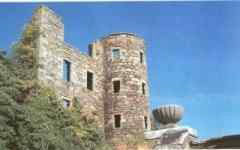 |
| The area around Ellon has been turned into a rich agricultural area through hard work and innovation as told in the words of many traditional 'bothy' ballads. The River Ythan also bought commercial importance to Ellon through the use of shallow drafted boats from Newburgh, operating a shipping service into the Meadows in Ellon until about the 1950s. Goods such as coal and lime were brought up river and the likes of grain and other farm produce would go down stream. |
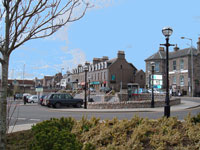 |
Since the 1970's Ellon has grown rapidly. The advent of North Sea Oil and the associated demands for new development to house incoming workers saw the town grow rapidly and its role change from a traditional market centre for the surrounding rural area to a commuter town for Aberdeen. Today, the majority of the town's residents are employed out with the town and look to Aberdeen for many shopping and leisure services and activities. The thrust of the Strategy for the town is to ensure a more sustainable future for the town with a better balance of work, life and leisure, building on the many attributes, qualities and opportunities the town presents. |
| Ellon now provides an ideal base for visitors wishing to visit National Trust and Historic Scotland properties in the area, as well as being close to magnificent beaches and coastal villages. The town is also a good centre for bird watchers with several estuary sites, inland lochs, and cliff nesting sites nearby. |
| Places of Interest in and around Ellon |
The Old Bridge: Known as the 'Auld Brig' this category A listed bridge built in 1793 stands to the east of the new road bridge and is open to pedestrian traffic.
Moot Hill Monument: The site of the court of the Celtic Mormaers and the Norman Earls of Buchan is located next to the Riverside car park and today is marked with a small monument and seating area. |
|
The Episcopal Church of St Mary’s on the Rock over looking the south bank of the Ythan was built in 1875, its original predecessor built in 1713 having been demolished by troops searching for Jacobites. Ellon’s parish history stretches back over 900 years. However, the present church was designed by George Edmund Street, the eminent Victorian architect, and is based on the design of the mediaeval parish church of Ellon, which was destroyed in 1776. It is a Grade A listed building and was opened on June 23rd 1871. It was consecrated on September 8th 1875. This church replaced a smaller church at Craighall, which was opened in 1816 and which itself had replaced a series of "hidden" chapels used by the congregation during the days of the persecution of Episcopalians following their involvement in the Jacobite Risings.
Esslemont Castle, lies approximately 2 miles west of Ellon on the A920 Esslemont is was passed by marriage from the family of Mareschal to the Cheynes of Straloch in the 14th century. The castle was then destroyed as the result of a feud between the Cheynes and the Hays. Later the hall was rebuilt but lost to the Earls of Errol during the reformation. It was sold in 1728 to Robert Gordon who abandoned it in favour of a new structure in 1769. |
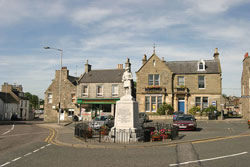
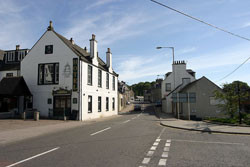
|
Esslemont Castle, lies approximately 2 miles west of Ellon on the A920 Esslemont is was passed by marriage from the family of Mareschal to the Cheynes of Straloch in the 14th century. The castle was then destroyed as the result of a feud between the Cheynes and the Hays. Later the hall was rebuilt but lost to the Earls of Errol during the reformation. It was sold in 1728 to Robert Gordon who abandoned it in favour of a new structure in 1769.
Arnage Castle some 4 miles north west of Ellon between the A948 and the B9005. The castle is a z plan tower house to which a modern wing was added last century by the Aberdeen architect James Matthews. The caste was built by the Cheyne family, who held the lands from 1380 – 1643. In 1702 it was acquired by Baillie John Ross, later Provost of Aberdeen, who later the same year took over the house in the Shiprow, Aberdeen, which still bears his name. |
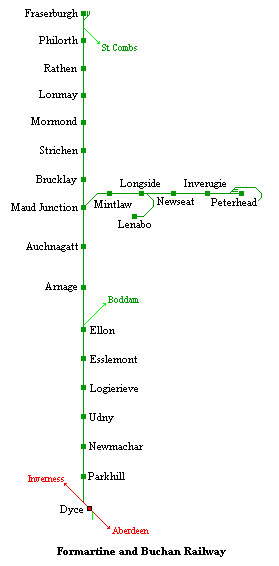 |
Ellon Riverside Park: The riverside area is easily accessible to the public and includes a footpath which runs alongside the river for the length of the town. A wealth of wildlife is found in this area, including herons, salmon, trout and even the elusive otter. The river was previously a rich source of pearl mussels and one pearl found in the river was of such high quality that it was presented to King James VI and now forms one of the brightest jewels in the Scottish Crown.
The town has a library, community centre, swimming pool and sporting and recreation facilities that include fishing, bowling, football, tennis, cricket and an 18-hole golf course. Still a market town with associated agricultural engineering industries, Ellon expanded in the 1970s to accommodate workers in the oil industry. The Ythan Raft Race a renowned attraction from Ellon to Logie Buchan used to take place each summer, sadly no longer occurs. There are guesthouses hotels, bed and breakfasts and self-catering cottages in Ellon, so you won’t have difficulty finding a place to stay for a night or a week.
To the east of Ellon lies Cruden Bay and one of the chief fishing ports in Aberdeenshire, Peterhead. Five miles to the west of Ellon is Pitmedden Garden (NTS) composed of beautiful parterres originally laid in 1675. Nearby are the ruins of the 16th century Tolquhon Castle. Six miles North West of Ellon is Haddo House. Designed by William Adam, Haddo House is one of Aberdeenshire’s finest stately homes. A couple of miles south east from Ellon lies Forvie National Nature Reserve. Visitors here will see Neolithic and Medieval Remains as well as range of wildlife including the largest population of breeding eiders in Scotland. North of Ellon is Bullers of Buchan a spectacular archway over the sea. From here walking south will bring you to the ruins of Slains Castle while heading north you’ll find Longhaven Reserve. Alternatively, those with cultural interests can find out more about the local area at the Tarves Heritage Centre, some 8 miles west of Ellon. For additional information browse www.visitellon.co.uk |
At one time Ellon could be accessible by train, it was once home to one of the many stations which formed part of the line connecting Aberdeen, Peterhead and Fraserburgh. Sadly the line was closed on October 6, 1979 an asset which could have been in popular demand today. Although the line has long gone it has made way for a cycle or walking path great for recreational purposes, a pleasant route with fabulous views and different outlooks over the country side.
|
|

